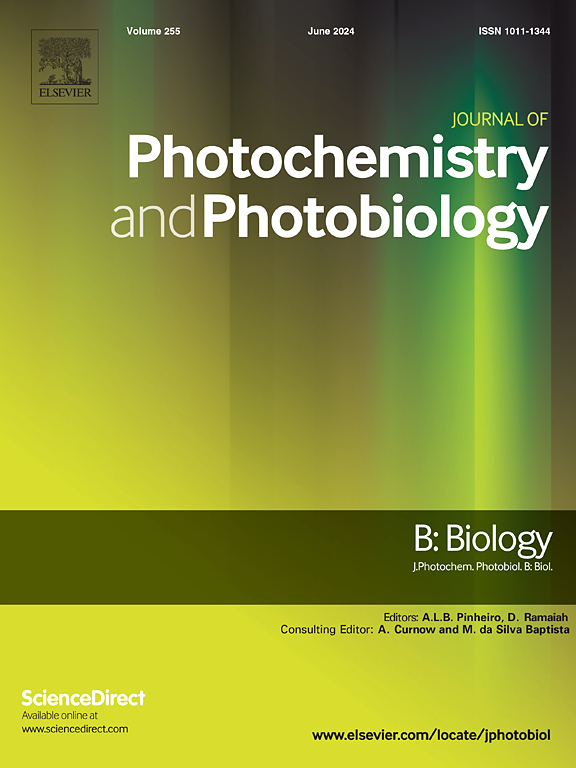Chemiluminescent and fluorescent properties of extracellular red pigment from Talaromyces purpureogenus
IF 3.7
2区 生物学
Q2 BIOCHEMISTRY & MOLECULAR BIOLOGY
Journal of photochemistry and photobiology. B, Biology
Pub Date : 2025-05-06
DOI:10.1016/j.jphotobiol.2025.113178
引用次数: 0
Abstract
Talaromyces purpureogenus is an attractive option for natural pigment production owing to its ability to produce large amounts of water-soluble extracellular red pigments. Recently, natural pigments have been used to develop halochromic biosensing applications, in which the colour change acts as a signal in response to a stimulus; however, the shelf-life and signal generation ability of packaging employing natural pigments maybe suboptimal because of potential reactions with environmental factors. Therefore, this study aimed to develop an alternative method for producing measurable signals from pigments. For this, the chemiluminescent and fluorescent properties of the pigments were explored. The pigment exhibited luminescence when exposed to hydrogen peroxide, which was affected by the reactant concentration, pH levels, and incubation time. Moreover, a rapid signal enhancement exceeding eight-fold was developed by adding luminol. The fluorescence spectrum was strongly affected by pH, with alkaline pH markedly increasing the fluorescence. Fluorescence was also found to be dependent on incubation time, with the maximum signal obtained at pH 12 and 72 h (∼16-fold increase over 0 h), and a model for the increase in fluorescence with time was developed (0.90 < R2 < 0.99). The identification of pigment components confirmed the presence of atrorosin R, which had an isochromene/isoquinoline ring, and elucidated the planar structure of this pigment. These findings may aid in developing novel biosensors utilising fungal azaphilone pigments.

Talaromyces purpureoogenus细胞外红色素的化学发光和荧光特性
Talaromyces purpureogenus是天然色素生产的一个有吸引力的选择,因为它能够生产大量的水溶性细胞外红色色素。最近,天然色素已被用于开发变色生物传感应用,其中颜色变化作为响应刺激的信号;然而,由于与环境因素的潜在反应,天然色素包装的保质期和信号生成能力可能不是最佳的。因此,本研究旨在开发一种从色素中产生可测量信号的替代方法。为此,对颜料的化学发光和荧光特性进行了研究。过氧化氢对色素的发光作用受反应物浓度、pH值和孵育时间的影响。此外,加入鲁米诺可使信号快速增强8倍以上。荧光光谱受pH值影响较大,碱性pH值显著增强荧光光谱。荧光也被发现依赖于孵育时间,在pH 12和72 h时获得最大信号(在0 h内增加~ 16倍),并且建立了荧光随时间增加的模型(0.90 <;R2 & lt;0.99)。通过对色素成分的鉴定,证实了含有一个异色胺/异喹啉环的atroosin R的存在,并对该色素的平面结构进行了分析。这些发现可能有助于开发利用真菌氮唑啉色素的新型生物传感器。
本文章由计算机程序翻译,如有差异,请以英文原文为准。
求助全文
约1分钟内获得全文
求助全文
来源期刊
CiteScore
12.10
自引率
1.90%
发文量
161
审稿时长
37 days
期刊介绍:
The Journal of Photochemistry and Photobiology B: Biology provides a forum for the publication of papers relating to the various aspects of photobiology, as well as a means for communication in this multidisciplinary field.
The scope includes:
- Bioluminescence
- Chronobiology
- DNA repair
- Environmental photobiology
- Nanotechnology in photobiology
- Photocarcinogenesis
- Photochemistry of biomolecules
- Photodynamic therapy
- Photomedicine
- Photomorphogenesis
- Photomovement
- Photoreception
- Photosensitization
- Photosynthesis
- Phototechnology
- Spectroscopy of biological systems
- UV and visible radiation effects and vision.

 求助内容:
求助内容: 应助结果提醒方式:
应助结果提醒方式:


